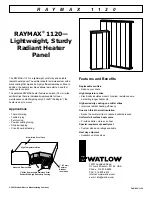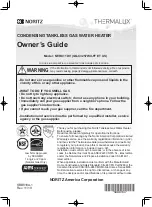
Page 17
8 - If B-1 vent or an insulated flexible vent pipe cannot
be used as liners, the chimney must be rebuilt
to accommodate one of these methods or some
alternate approved method must be found to vent the
appliance. When inspection reveals that an existing
chimney is not safe for the intended purpose, it
shall be rebuilt to conform to nationally recognized
standards, lined or relined with suitable materials
or replaced with a gas vent or chimney suitable for
venting unit heaters. The chimney passageway must
be checked periodically to ensure that it is clear and
free of obstructions.
REMOVAL OF UNIT FROM COMMON VENT
In the event that an existing unit heater is removed from a
venting system commonly run with separate gas applianc-
es, the venting system is likely to be too large to properly
vent the remaining attached appliances. The following test
should be conducted while each appliance is in operation
and the other appliances are not in operation, yet remain
connected to the common venting system. If the venting
system has been installed improperly, the system must be
corrected.
1 - Seal any unused openings in the common venting
system.
2 - Visually inspect the venting system for proper size and
horizontal pitch. Determine there is no blockage or
restriction, leakage, corrosion, or other deficiencies
which could cause an unsafe condition.
3 - In so far as is practical, close all building doors and
windows and all doors between the space in which
the appliances remaining connected to the common
venting system are located and other spaces of the
building. Turn on clothes dryers and any appliances
not connected to the common venting system. Turn
on any exhaust fans, such as range hoods and
bathroom exhausts, so they will operate at maximum
speed. Do not operate a summer exhaust fan. Close
fireplace dampers.
4 - Follow the lighting instructions. Place the appliance
being inspected in operation. Adjust thermostat so
appliance will operate continuously.
5 - Test for spillage at the draft hood relief opening after
five minutes of main burner operation. Use the flame
of a match or candle, or smoke from a cigarette,
cigar, or pipe.
6 - After it has been determined that each appliance
remaining connected to the common venting system
properly vents when tested as outlined above, return
doors, windows, exhaust fans, fireplace dampers
and any other gas-burning appliance to their previous
condition of use.
7 - If improper venting is observed during any of the
above tests, the common venting system must be
corrected. The common venting system should be
resized to approach the minimum size as determined
by using the appropriate tables in Appendix G in the
current editions of the ANSI Z223-1, or the appropriate
Category I Natural Gas and Propane appliances
venting sizing tables in the current standards of the
CSA-B149 for installation compliance codes.
Electrical Connections
NOTE - Local codes may supersede any of the provisions
outlined in this instruction.
THERMOSTAT WIRING
The
unit heaters use a direct spark ignition system.
There is no pilot necessary as the spark lights the main
burner when the gas valve is turned on. The direct spark
ignition control board (A3) emits radio noise as the
sparking process is under way. The level of energy may
be sufficient to disturb a logic circuit in a microprocessor
controlled thermostat. It is recommended that an isolation
relay be used when connecting the unit heaters to a mi-
croprocessor controlled thermostat.
250-400 Units Only:
Units are shipped from the factory
in two-stage heating mode. When using a single-stage
thermostat or control, jumper W1 & W2 terminals on P367
5-pin thermostat plug.
Install the thermostat according to instructions provided.
Route thermostat wiring into the unit heater using the ther-
mostat inlet(s) shown in the Unit Heater dimensions in the
front of this instruction. Use 18 gauge wire or larger for
thermostat connections.
Connect thermostat wires to 5-pin P367 thermostat plug
located on the A3 ignition control board. See figure 10.
For ease of installation, disconnect P367 plug from J367,
make wire connections, and replace P367. Refer to dia-
gram on unit and appropriate diagram in this instruction.
An additional thermostat wire must be run to terminal “G”
on heater when continuous blower is desired.
P367
TERMINAL
DESIGNATIONS
P366
TERMINAL
DESIGNATIONS
LINE VOLTAGE
PLUG
(125-400 ONLY)
30-105 UNITS - CONNECT LINE
VOLTAGE TO FACTORY-
IN MAKEUP BOX
(105-400 ONLY)
THERMOSTAT
PLUG
P367 5-PIN
P366 2-PIN
FIELD WIRING CONNECTIONS
INSTALLED PIGTAILS
FIGURE 10












































